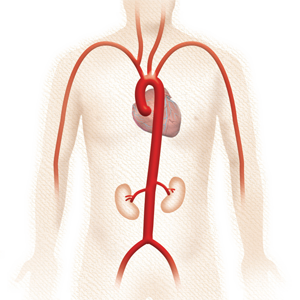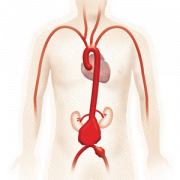Aortic Disease Awareness
Share your aortic story with social media hashtags #ThinkAorta and #AortaEd.

What is the Aorta?
The aorta is the main artery in your chest and abdomen that carries and distributes blood from your heart to almost every part of your body. You can think of it as the water mains that supplies water to the entire city.
What diseases affect the aorta?
Like any pipe, the aorta can leak or rupture, disintegrate, weaken and swell, or it can narrow and block off.
We commonly talk about the following aortic conditions:
- Aortic dissection
- Aortic aneurysm
- Aortic trauma
- Aortoiliac occlusive disease
Aortic Dissection
This is where the layers of the aorta separate into a “double-barrel” appearance. This can lead to rupture, or stop blood flow to vital organs such as the heart, brain, kidneys, gut or legs. Up to 90% of patients die in the first 24 hours, but there is increasing evidence that if patients make it in time to a hospital with adequate facilities and specialist expertise that many of them can be saved.
Early survival from aortic dissection varies widely based on the specific part of the aorta and which branches may be involved. Traditionally major open surgery has been the only means of treating aortic dissection, but in recent decades advancements in endovascular technology have opened up options for minimally invasive or hybrid surgical approaches to treatment. Nevertheless key to treatment is early recognition and good clinical suspicion, initial investigation and rapid referral by primary care and emergency physicians.
Notable people who have died of aortic dissection include Depeche Mode keyboardist Andy “Fletch” Fletcher in June 2022 age 60, actor Alan Thicke in 2016 age 69, US diplomat Richard Holbrooke in 2010 age 69, actor and musician John Ritter in 2003, Rent composer Jonathan Larson in 1996, and King George II who died in 1760 age 57.
One of the pioneers of Aortic Dissection surgery Dr Michael Debakey actually suffered a dissection in 2005 at the age of 97, had emergency surgery and survived in good health for another 3 years. Judas Priest guitarist Richie Faulkner survived an acute aortic dissection in 2021 after undergoing emergency surgery, as did NZ Cricketer Chris Cairns in August 2021 and US Senator John Boozman in 2014.

Aortic Aneurysm
This is where the walls of the aorta weaken and the artery dilates and swells like a balloon. The larger the artery gets the greater the risk of rupture. Many patients never know that they have this condition until they get an ultrasound or CT scan. When people die suddenly without explanation this can be due to an undiagnosed aortic aneurysm.
Standardised global analyses have found a reduction in worldwide deaths from aortic aneurysm of 2.9 deaths/100,000 people in 1990 to 2.2 deaths/100,0000 people in 2017. This reflects up to 150,000-200,000 deaths per year worldwide.
Early detection and monitoring together with advances in minimally invasive endovascular aortic surgery mean that risk factor management and surgical treatment can be targeted and delivered to the right patients to prevent rupture. High-risk target groups include men over 65 with a smoking history, where abdominal aortic aneurysms can be as common as 1 in 12 men, and patients with a family history of sudden death, known aneurysm, or other inherited disorders known to be associated with aortic aneurysms such as Marfan Syndrome, and Loey-Dietz Syndrome. Ongoing research into control and treatment strategies for aneurysmal disease is a key focus of cardiovascular research.
Notable people who have died of aortic aneurysms include actor and musician Jon English who died in 2016 at the age of 66 after complications from aortic aneurysm surgery, South-Australian racing car driver and manufacturer Garrie Cooper in 1982 of a ruptured aortic aneurysm age 47, veteran Australian Rules footballer, umpire and commentator Mick Cronin in 1979 age 68, and Geelong VFL player Johnny Keon who died in 1921 age 35 of what was reported as a ruptured aortic aneurysm.
Sports Journalist Grant Wahl died of a ruptured ascending aortic aneurysm in 2022, investigative journalist Andrew Jennings died of an aortic aneurysm in January 2022 age 78, co-creator of the game Dungeons & Dragons Ernest Gary Gygax in 2008 age 69, British rock musician and bassist for The Animals Chas Chandler in 1996 age 57 whilst undergoing tests for an aortic aneurysm, actress Lucille Ball died in 1989 age 77, and Albert Einstein died in 1955 aged 76 after initial surgery in 1948.
NBA basketballer Jeff Green underwent successful aortic aneurysm repair in 2012 as did US Senator Bob Dole in 2001 before Sen. Dole died in December 2021 with advanced lung cancer.
Aortic Trauma
This is when there has been direct injury to the aorta such as penetrating injury, or blunt force injury such as from a motor vehicle accident the aorta can transect or rupture. This results in immediate bleeding and often rapid death unless the patient can be transported to hospital immediately and the bleeding controlled. Rarely, surgery close to the aorta can result in unintentional injury. In most cases this can be controlled immediately and repaired by a vascular surgeon.
Formula One driver Roland Ratzenberger sustained an aortic transection as part of his fatal injuries from a crash during qualifying for the San Marino Grand Prix in 1994. US Indycar driver AJ Foyt is said to have survived an aortic injury sustained in a NASCAR race in 1965.
The widespread installation of seatbelts in cars, along with other safety measures has dramatically reduced the incidence of rapid deceleration injuries and traumatic aortic transection.
Aortoiliac Occlusive Disease
This is where the channel of the aorta narrows and blood flow to the legs is reduced usually because of plaque and atheroma inside the artery. This is more common in older people but can happen in younger patients, especially if they are heavy smokers or have diabetes. Typically patients develop pain and early fatigue in the buttock, thighs and calves when walking distances due to restricted blood flow.
Aortoiliac occlusive disease is a form of peripheral arterial disease and in extreme cases can lead to ulcers, gangrene and amputation. Early detection through a review with your GP and ultrasound where appropriate can determine whether a specialist vascular surgical review is necessary.
What can I do?
If you or a family member have been diagnosed or suspected to have one of these conditions then you should be reviewed by a vascular specialist who can determine whether any more tests or treatment are required and answer your questions.
Quality treatment of these conditions requires a team-based approach with specialist vascular and cardiac surgeons, radiologists, emergency physicians, anaesthetists, critical care doctors, as well as input from a wide variety of medical specialists, nurses and allied health teams.
These teams can only function in hospitals with the right facilities and infrastructure such as emergency department and intensive care unit capacity, open surgical, endovascular and hybrid operating theatres, and most importantly staffing and funding to operate them.
If you have had an aortic disease then you can share your story amongst your friends, family and social media to help raise awareness with the hashtags #ThinkAorta and #AortaEd. You can also support your local hospital through fundraising and volunteering activities, or via your local or regional government representatives. If you would like to support vascular surgical research, education and advocacy on aortic disease awareness then please consider a donation to the ANZSVS Vascular Foundation.
